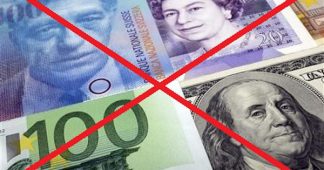Paying with a type of government bond as a supplement in a dollarized country
(working paper)
ABSTRACT: A country that does not issue its own currrency is dependent on a foreign currency, for example USD or EUR (we use “$” for convenience in this note). The country’s government is then extra constrained, because it cannot create more national currency when needed. At the same time there may be a strong political resistance to leaving the foreign currency and (re)introducing a national currency. This paper discusses the alternative of introducing some nationally issued instrument that can function as an additional means of payment, not only from the government to providers, but also between agents in the private sector. The option launched here is a form of bond that the government uses to pay providers and individuals, in addition to using the scarce foreign currency. For such bonds to gain confidence, it is assumed that they may be used to pay taxes, counting at the nominal foreign currency value of the issued bond.The bond exists only as an electronic deposit at the central bank, not as a paper document.
A program proposal for creating a complementary currency in Greece
with co-author Robert W. Parenteau
(page 2 in the Real-World Economics Review, issue 71, 28 May 2015)
ABSTRACT: This paper describes the concept of a national “complementary” or “parallel” currency, and the advantages of implementing it in the form of purely electronic money – no bills and coins. It suggests a fairly detailed program for how a parallel or complementary currency to the euro could be introduced in a crisis-hit eurozone country, focusing on Greece. Finally, some questions and counterarguments are addressed.
Here, on the Real World Economics blog, is a brief and updated (10 August 2015) version of the proposal
The Central Bank with an expanded role in a purely electronic monetary system
(page 66 in the Real-World Economics Review, issue 68, 21 august 2014)
ABSTRACT: Physical currency (bills and coins) is being phased out as an important means of exchange both in developed and developing countries. Transactions are increasingly done by debit card, computer, and mobile phone. This technologically driven process opens up some very useful possibilities, among these new and — for society — beneficial roles for the Central Bank. The paper assumes a scenario where the country in question issues its own currency, and all money is “electronic” — no bills and coins. This gives an extra impetus to the sovereign money solution; all deposits are at the Central Bank.
The paper also argues that in such a system — where banks are not allowed to create “credit money” when issuing loans (in this resembling the “100% reserve” solution supported by many reformers) — the economy need not, in spite of this, be “starved” of credit for investment — a warning that is not only sounded by the defenders of today’s financial system, but also by many of its critics. This goal might be achieved by the unconventional trick of letting commercial banks create the needed sovereign money at the Central Bank for their lending.
A third point of the paper is to argue that simplification of the financial system should be a goal in itself.
A simple proposal to kill high frequency trading in the stock market
This is a short note (also here, in the Real World Economics blog) that suggests how one could get rid of the current parasitical and absurd automated microsecond-scale trading activity. It can also be applied to reduce “day trading”.
Physical and social systems may be modeled with the same sort of tools!
This is a short note challenging heterodox economists that are “math-averse”, more generally arguing for systems theory applied to human groupings.
How banks are able to create additional credit money (bank-m-creation.pdf)
This note tries to explain, in a simple manner via an imagined example, how a bank is able to create extra “credit money” when lending. A less intuitive and more comprehensive treatment is in this paper below.
No, there need not be lack of credit with “100 % money” (credit-100pc.pdf)
(This is a brief note.)
ABSTRACT: This is a defense of “100% money” as in the famous Simons, Fisher et al Chicago Plan 1933 – 1936, recently supported by Kumhof and Benes in a paper. I argue on this point against another paper by Ann Pettifor, who holds that 100% reserve requirements means that society will be starved of credit. That said, I am in agreement with Pettifor on her other points, for instance her critique of the theory of the money multiplier, unregulated banks and neoclassical economics more generally.
Improved Macroeconomic Control with Electronic Money and Modern Monetary Theory
(HERE, in the Real-World Economics Review, issue 63, 25 March 2013)
ABSTRACT: This paper combines the concept of electronic money (no physical currency) with Modern Monetary Theory (MMT). It argues — based on an MMT understanding of macroeconomics — how electronic monetary systems offer a big step forward for macroeconomic control, among other things by giving a government new and potent steering tools. More specifically the paper discusses how one in an electronic money environment can easily curb an overheated economy primarily through control of money velocity — not money supply. This is a necessary topic to explore, even if the opposite is needed in today’s global situation, to convince academics and decision makers that running necessary large and persistent government budget deficits in depressed economies, is not “irresponsible” and does not need to imply strong inflation in later economic boom situations.
Ten advantages and two possibilities with a parallel electronic currency (mobile-dollars.pdf)
(This is a one-page note summing up and extending the main points in the first paper below)
A recipe for a country to gradually and possibly exit from the eurozone through a parallel emergency currency realised via the mobile phone network (paper-wolfson.pdf)
(submitted 27/1-2012 for the 2012 UK Wolfson Economics Prize competition. A more recent and updated version is here on page 14, a collection of papers from a seminar in Berlin, July 2012, convened by The German Association for Small and Medium-sized Businesses.)
ABSTRACT: Today’s information technology and mobile phone networks make it possible for eurozone governments, or even non-government entities, to establish and run a national parallel (to the euro) paperless monetary system at very low cost and launch it on very short notice. The workings of such a system run by the government, is described and discussed. Such systems may ameliorate the dire state of affairs in the hardest affected eurozone countries, by strongly and quickly decreasing unemployment and increasing business activity, including activity that enables the country to better service debt in euros. Since the proposed monetary system exists in parallel with euros, there is no abrupt break with the current monetary arrangements. Instead one gets a slower controllable process where the management of, and balance between, the two parallel systems may be gradually adjusted based on how things develop. This process at any time allows the choice between two options: reverting to a pure euro system, or ramping up use of the parallel currency with an ulterior goal of leaving the euro completely and reinstating a national currency.
(Note: This submission resembles the paper below about “Greeks etc.“)
Capitalists can enjoy a persistent profit flow in an economy with no injection of fresh money (profit-poss2.pdf)
(This is a brief provocative note.)
ABSTRACT: There is a large and elaborate literature in economics about the (in)feasibily of capitalists in the aggregate enjoying a stable profit. Many conditions have been put forward for this to be feasible, for instance that extra (“fresh”) money must be persistently added to the system, typically in the form of bank credit. This brief note argues that this is not necessary, and that this is very simple to conclude by using a continuous time linear model of a closed economic circuit. The paper also explains Marx’ m-c-m’ puzzle. Furthermore it argues that a constant — not falling — profit rate is feasible, and that this profit rate is independent of capitalists’ share of output.
The fundamental mechanism behind the global financial crisis (sysdyn-debtcrisis.pdf)
This is a lecture note (October 2011) for my students in system dynamics. It is very simple, but because of that I believe it makes the crucial point clear.
What if the Irish, Baltics, Spaniards, Greeks did this?
– A high-tech parallel monetary system for the underdogs (greece-etc-2.pdf)
Paper presented and in the proceedings of the 9th Society of Heterodox Economists Conference, December 6 and 7 2010, UNSW, Sydney. The paper was revised in October 2011. The first, and shorter, version appeared in Counterpunch June 25 – 27, 2010. The latest version is here, in the Real-World Economics Review, issue 59, 12 march 2012.
A long-range financialisation mechanism (financiali3.pdf)
ABSTRACT: One prominent characteristic of the decades-long run-up to today’s global financial crisis is the increasing relative size of debt and the financial sector in countries’ economies. A mechanism explaining this, related to financial accumulation through non-financial capitalists’ lending, is explored. The exercise also leads to the conclusion that in the aggregate, financial accumulation by capitalists through the alternative option of real-economic investment, is not feasible.
(This is a working paper).
Fundamental financial accumulation dynamics (accum-08.pdf)
ABSTRACT: Any economic system with interest on money lent has the potential to gradually develop a level of debt that leads to crisis. Parameters and simple laws for the dynamics of financial accumulation are proposed and explored. It turns out that concepts from linear control systems theory, and continuous-time representation, are very useful for this exercise. It is argued that the problem of “exploding” debt is grave and largely ignored.
(This is a working paper).
Basel rules, endogenous money growth, financial accumulation and debt crisis (basel.pdf)
ABSTRACT: A Basel-type bank regulation regime has the side effect of endogenous money growth. The growth rate turns out to be inversely proportional to the required minimum capital/asset ratio. This money growth contributes to avoiding debt crises, as opposed to non-bank lending which increases debt but not money stock, and is therefore dangerous in the long run. Banks often prefer to sell loans onwards. It is shown that this doesn’t only decrease the bank’s risk, it may also imply faster asset growth for the selling bank by allowing an increase in the flow of new extended loans.
(In: proceedings of the 12th Path to Full Employment Conference and the 17th National Conference on Unemployment, the University of Newcastle, Australia, December 2-3, 2010)
A block diagram approach to macroeconomics, and why IS/LM is fatally flawed (system-econ.pdf)
ABSTRACT: A dynamic model of an individual, and then an aggregate (sector), economic unit is developed. This model and other building blocks are employed to create macroeconomic models represented through block diagrams. A simulation tool based on block diagram representation is applied to a simple textbook economy with firms and households. Finally, a dynamic extension of the IS/LM static model is presented in block diagram form, and it is demonstrated through the dynamic extension that IS/LM’s way of treating money stock is flawed to a degree that implies that IS/LM must be discarded.
(This is a working paper).
A critique of a Post Keynesian model of hoarding, and an alternative model (hoarding.pdf)
ABSTRACT: The concept of a “propensity to hoard” is frequently used by Post Keynesians and Circuitists in time-discrete models of the macroeconomy, to account for how households manage their flow of savings. This concept is argued to be erroneous — and continuous circuit models are better than discrete for a clear understanding of this. The phenomenon of time dispersion of circulating money is discussed — also impulse functions and first order differential equations as building blocks in a network. Finally, these components and concepts are used to assemble and simulate a circuit model with debt. Even at high interest and savings rates the system evolves without ending in debt-induced crisis.
(Journal of Economic Behavior & Organization., Vol 60/2, pp 230-251, June 2006)
Two feasible future scenarios: A high-tech utopia − and a high-tech dystopia (html version)
(pdf version)
ABSTRACT: Two different far future scenarios are discussed: Both have a highly automated manufacturing sector with a small workforce, and a large labour-intensive service sector. The first, “utopian” scenario is inspired by the Marxian vision, with some important modifications: Limits to consumption still exists, certain goods and services are still exchanged in a market. It is argued that the Marxian utopia is a useful “asymptote” to strive for, even if it can never be reached.
The second, “dystopian” scenario has few workers in manufacturing just like the first. Manufacturing, and the much larger service/servant sector, is run on authoritarian capitalist lines. It is argued that profit rates can be sustained indefinitely in such an economy. The current worldwide attempts from corporations to take over service activities that have until now been in the public sector domain is discussed in the light of this.
(In: Proceedings of the 5th Path to Full Employment Conference and the 10th National Conference on Unemployment, Newcastle, Australia, December 10-12, 2003, also in the post-autistic economic review, no. 25, 21 May 2004.)
Overvaluation − not volatility − is the main danger in stock markets (stockmodel.pdf)
ABSTRACT: Real-world stock markets are volatile and expresses such traits as overvaluation, psychological moods, cycles and crashes. This paper develops and explores a model which have these properties. The model is aggregated, continuous and non-linear. It is developed in stages. In the initial stage it is applied to the price dynamics of one type of stock only. Later on it is applied to a weighted price index of different stocks, to try to capture the dynamics of a stock exchange as a whole. The purpose of the model is to gain insight both into short-term dynamics and stability properties, and the dynamics of long-range cycles and crashes. Based on the model, the transaction tax reform proposal to stabilise stock markets is discussed and rejected. Another and new stabilising idea is presented − substituting a stock with a type of bond.
(This is a working paper.)
A fairly similar paper, built on the same model, is this:
A countercyclical fee to eliminate long-term stock market booms and busts (stockm-fee.pdf)
(This is a working paper.)
The dynamics of long-range financial accumulation and crisis (dyn-of-accum.pdf )
ABSTRACT: A dynamic model of money stock/flow relations for a generic economic agent is developed, and employed to model and discuss the long-range (decades) impact of returns on any form of saved or invested money on a macroeconomy. It is shown that, subject to realistic assumptions about behavior of economic agents, a macro-economic system with positive returns must eventually reach a depression-like economic state. The observed disproportionate growth of financial sectors in recent years is explained by the proposed model. Simulation runs are presented. An indicator for economic fragility is proposed.
(In Nonlinear Dynamics, Psychology, and Life Sciences, Vol. 3 No. 2 April 1999.)
The macroeconomy as a network of money-flow transfer functions (network.pdf)
ABSTRACT: An introduction on A.W. Phillips’ “hydraulic” macroeconomic models is given. His (and others economists’) notion that a macroeconomy may reasonably be considered to have dynamics corresponding to a first order time lag transfer function, is justified in this paper by aggregation of individual micro agents. In connection with this economic application, I derive and discuss a theorem and some rules for general networks of time lagged blocks. Finally, Monte Carlo simulations of networks of micro agents are undertaken, supporting the validity of the first order time lag aggregate model.
(Modeling, Identification and Control, vol. 19 no. 4, 1998.)
Consumer power via the Internet (html, click here)
(this is quite old, but I leave it here for “historical” reasons, because I modestly 😉 consider the paper fairly prophetic at the time, 1999 …)
ABSTRACT: Albert Hirschman introduced the terms “voice” and “exit” to characterise the two main means for individual influence in an organisation. One may try to change something by speaking up or voting for another leadership “voice”. Or one may quit the organization “exit”. As a consumer, your option is “exit” only by stopping buying a given product. Your “voice” will never reach the corporation, or it will be ignored. This paper describes a simple and cost-free reform to give consumers effective “voice”: free discussion pages about a corporation’s products and practices by law prominently linked from its main web page and referred to in its advertising. Corporations are obliged to reply and participate. Corporations’ compliance is supervised by a public consumer’s agency.
(First Monday, volume 4, number 1, 1999.
For those who read Norwegian: En utvidet versjon av denne artikkelen sto som kronikk i Aftenposten, 22. juli 2002)











